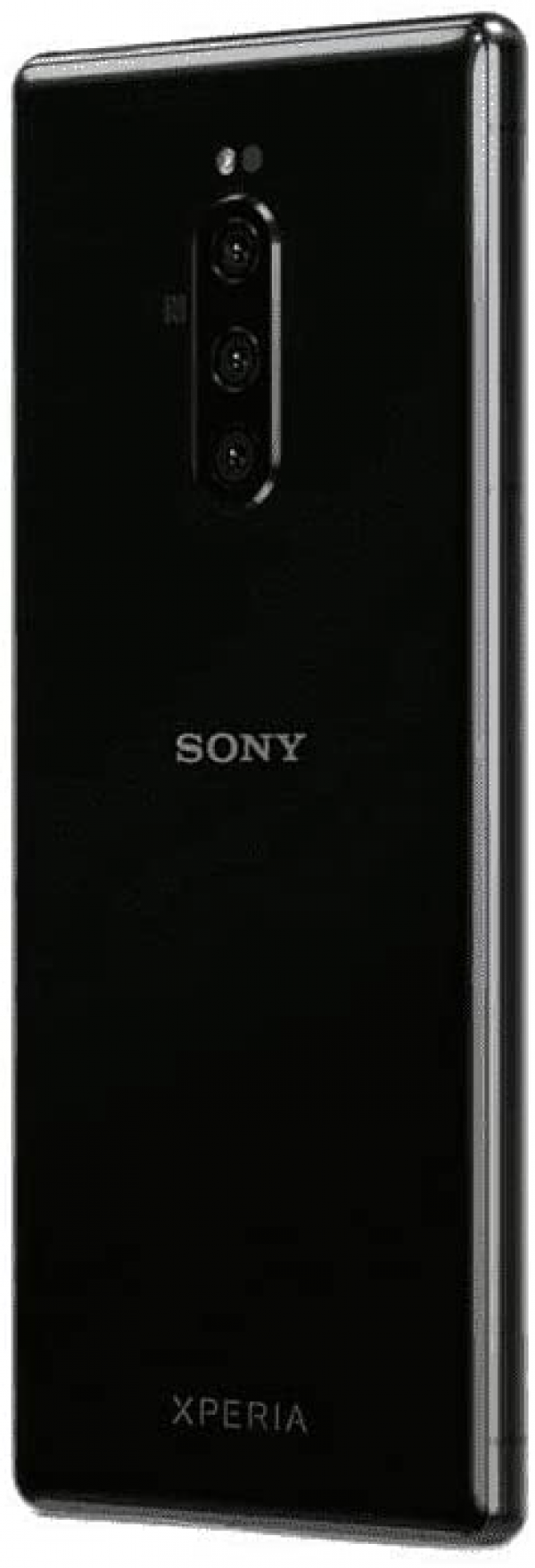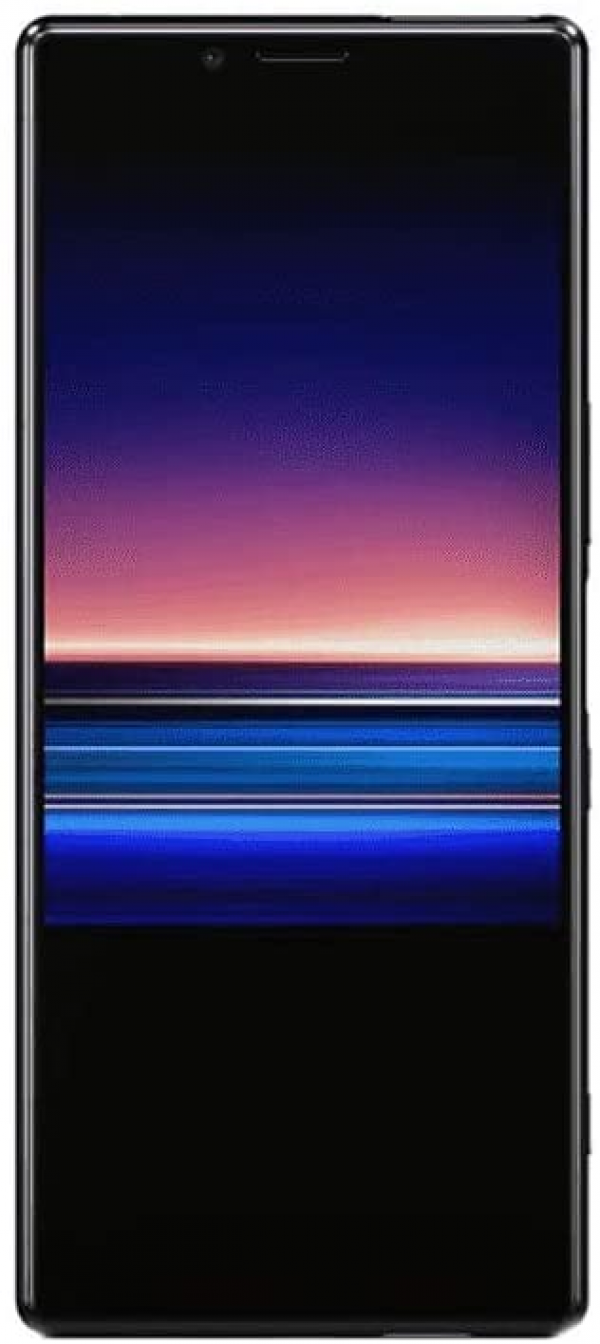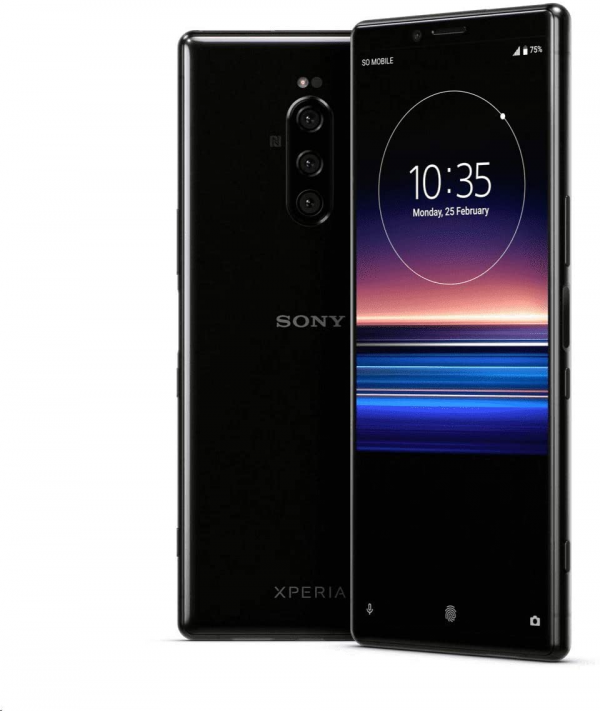Sony
Sony Xperia 1: a screen of the most beautiful effect
Aprox. 695€ - see price -
See specificationsWith the Xperia 1, Sony wants to revitalize its smartphone division. Here is a smartphone equipped with an Oled 21: 9 panel, a triple photo module on the back and a state-of-the-art chip. Enough to convince? The answer here.
Our review
Presentation
Struggling in the smartphone market, Sony is restructuring. The Japanese company thus merged its mobile, TV and photo branches in March 2019. The opportunity to combine the know-how of these different divisions at the same time. So comes the Xperia 1, a smartphone with ambitions on the side of the screen, the photo, and in the format still not widely used.
Proposed at 999 €, the Xperia 1 faces the flagships of the competition, such as the Galaxy S10 + from Samsung, the Pixel 3XL from Google, the iPhone XS or even the P30 Pro from Huawei.

Ergonomics and design
With its 6.5-inch screen in 21: 9 format, the Xperia 1 is a long-length smartphone. And as with the Xperia 10 and 10 Plus, this poses some problems in terms of ergonomics. The height of the terminal prevents smooth use with one hand, even if the narrowness of the smartphone allows it to cover its entire width thanks to the thumb. Unfortunately, the volume buttons, located on the right edge, are a little high and the unlock button, a little low. The best positioned button is finally the fingerprint sensor also located on the right edge. Rather reactive and reliable, it naturally falls under the finger.
The finishes of the smartphone are however flawless. The glass back of the smartphone proves to be of the most beautiful effect despite a certain ease in catching fingerprints. The facade is equally worked, despite a slab which occupies only 82% of the surface. The fault with too imposing upper and lower borders.
High-end requires, there is a USB-C connection on the lower edge of the smartphone. Capable of accommodating two nanoSIMs, the Xperia 1 also has a port for microSD cards up to 512 GB. The smartphone also offers 128 GB of internal memory, including 4 GB used by the operating system. Finally, the Xperia 1 is IP 68 certified, so it is waterproof, like most of its competitors.

Screen
For its Xperia 1, Sony offers us one of the most beautiful panels on the market and almost flawless. However, it should first be noted that the 6.5-inch Oled screen does not actually display in 4K (4,096 x 2,160 px) or even in UHD (3,840 x 2,160 px), because of its CinemaWide 21: 9 aspect ratio sweetening a few pixels on the height. We are therefore left with a definition of 3,840 x 1,644 px, for an excellent resolution (642 ppi). The colorimetry is just as excellent, as long as you take a little trouble.
To get the best out of the screen, you need to go through the settings, click on Display, then choose the Creator Mode screen profile and customize the white balance (see screenshots above). That done, the slate offers an exemplary color temperature (6,496 K) and a perfect average delta E (2,8) with controlled shades from start to finish. Added to this beautiful painting is the infinite contrast and the imperceptible afterglow, properties inherent in Oled.
The screen of the Xperia 1 is just as exemplary in terms of performance. It is thus able to climb up to 690 cd / m². Enough to stay readable even in direct sunlight, especially since it benefits from good quality reflectance. Conversely, the slab can go down to 1.6 cd / m² and is careful not to burn the user's retina. Finally, the only shortcoming of this panel is on the touch delay side, slightly too high (92 ms).
Performances
The Xperia 1 has the most powerful chip on the market today, the Snapdragon 855, composed of a Kryo 485 core clocked at 2.84 GHz, 3 Kryo 485 at 2.42 GHz and 4 Kryo 485 at 1.8 GHz. The whole is supported by 6 GB of RAM. An arrangement allowing Android 9.0 to work without the slightest problem. Juggling between apps is a breeze on Sony's smartphone.
When launching a game, the Adreno 640 chip takes over. She has no problem managing the greedy 3D games from the Play Store. Without suffering from a slowdown or a decline in graphic quality.
Audio
In good shape of 2019, the Xperia 1 does not have a 3.5 mm mini-jack connection. It will therefore be necessary to do with the USB-C adapter supplied in the box of the smartphone. An adapter that turns out to be quite average, despite a perfectly contained distortion and a wide dynamic range. It sins on the crosstalk, much too leaky, and the output power too low.
The dual speakers of the Xperia 1 are located on the upper and lower edges of the smartphone. And their rendering turns out to be rather good with a scene that is finally quite clear and spaced. Obviously, the Atmos effect once again highlighted is only marketing.
Photo
High-end 2019 requires, the Xperia 1 offers a triple photo module on its back, composed of three photo modules. In addition to a conventional wide-angle, we find a very wide-angle and a 2x zoom. A most classic combo that is found on more and more smartphones. All these beautiful people are articulated around the photo application developed by Sony, which always remains fluid, despite some slight ergonomic snags.
The main module of the Xperia 1 offers a 12 MP sensor supported by a lens opening to f / 1.6. By day, he takes halftone shots. Image processing is discreet, with preservation of quality at the periphery. There are even more dive than on a P30 Pro, for example. But the picture still suffers from an excess of noise, giving a slight feeling of blurring of camera shake. The scene is also very cold, with a white turning to blue, and perhaps a little underexposed.
At night, the Xperia 1 reacts rather well. The smartphone achieves a controlled increase in sensitivity (ISO 800) with an extended pause time (1/5 s). The whole is softened by an image processing, perhaps exaggerated. Finally, the scene is content to be readable and clear. A minimum for a smartphone launched at a thousand euros.
As on the main module, the very wide-angle shots are cold and marked by excess noise. An unfortunate rendering since the whole is rather well treated. Despite the short focal length, the photos are almost not distorted and the loss of quality at the periphery is contained.
At night, the very wide angle of the Xperia 1 does pretty well. Despite a scene drowned in noise, the center of the scene is rather legible. This time the periphery does not escape the vignetting effect, slightly present.
Finally, the third and last module of the Xperia 1 dedicated to 2x zoom is also satisfactory. At least by day. Always noisy, the scene is clear up to the periphery. The whole unfortunately remains a little cold. For its part, the P30 Pro and its 5x zoom holds the competition.
At night, the Xperia 1 switches the 2x zoom on its main module, the result is therefore not very usable and not very interesting. But it's hard to blame the smartphone as its competitors share this trend.
The back portrait mode of the Xperia 1 uses the 2x zoom module supported by the main module to assess the depth. And it must be said that the combo is quite effective. The bokeh is progressive while the cutting is precise, even when faced with curly hair. At the front, the result of the portrait mode is slightly less convincing, while remaining of quality. The front photo module consists of an 8 MP sensor and a lens opening to f / 2.0. The pictures he takes certainly lack sharpness, but remain realistic.
With the Xperia 1, Sony wants to set foot in love with the seventh art. His argument is a smartphone with an Oled 21: 9 panel, but also ...
Finally, the Xperia 1, dedicated to videographers above all, offers an application dedicated to video, Cinema Pro, which we have analyzed in detail in a lab article. The photo application is also capable of filming, in 4K and with great fluidity. Video renderings are clean, regardless of the definition chosen.
Autonomy
Like the Xperia XZ3 released just under a year ago, this Xperia 1 offers very average autonomy. Despite its 3,300 mAh battery, the smartphone only lasted 13 h 35 min during our SmartViser autonomy protocol. This corresponds to approximately two days of autonomy in real conditions. An honest result, but far from the competition standards.
Using the charging block provided, the Xperia 1 fully charges in approximately 1 h 45 min.
Conclusion
As usual, Sony offers a sawtooth smartphone. Despite a screen of very good quality and good performance, the Xperia 1 is not convincing enough in photo to make up for its shortcomings in autonomy. So we end up with a smartphone a notch below its direct competition, whether the Huawei P30 Pro or the Samsung Galaxy S10 +.
Specifications
Reviews


Don't believe the reviews!
Something is wrong with reviewers. Not sure what it is, maybe they are just being paid but the 'big guys'. But I really don't understand why phones like this get such a bad press. This is a sleek, well built phone, with few of the annoying extras eg Bixby! Fingerprint scanner on the side (where it should be) works well. Camera works well. Call quality so good I think my old Note 9 must have been faulty. Just go a try it!
Best phone money can buy for power users who really
This 4K phone will be wasted on 99% of people out there, this phone is for genuine hardcore power users, that really demand the most functionality & interoperability with a multitude of external devices.
LTE + support out the box (what's being referred to as current 5G), Cat12 WiFi with the newest mimo antenna fastest speed there is), Real-time image enhancement processing (not just over saturation like other phones), HDR color accuracy something no other OLED can do (which typically have super inaccurate color levels & their brightness depends on portioning if on screen voltage), Dolby Atmos surround that I must say deliver the clearest stereo speaker audio I've heard to the point you can turn the volume way down and still understand what people are saying, but boy can it get loud too without the normal harsh clipping that usually happens with other phones. Then there's the stereo HD noise suppressing microphone, I tested this with roommates, and I was told it's as if I was standing next to them. The microphone also samples your environment for a split second whenever you say okay Google or start doing a voice search.
Intuitive software that speeds up how quickly & productive you can be with a phone. However it's best experienced after setting up all your preferences, which make it easy to unlock your phone as soon as you reach for it do to scanner placement and suited & booted ready to work before eyes even have time to spy the lock screen.
This Sony phone is also smart enough to know when it's been accidentally touched (it'll tell you) or when you are looking at it, (it'll then show you the time), or when you want to take a picture just based on how you take it out of your pocket and the camera is already waiting for you to snap a photo with it's dedicated two stage physical camera button that autofocuses on mid press, for it's 3 + 1 (4) cameras that are all built to deliver bespoke results.
Video recording in 4K & HDR at the same time, something no other phone can do, with another DSLR feature of constant auto focusing while recording, again only phone capable of this. And don't expect oversaturated colors, this phone is Hell-bent on color accuracy, so if what you're filming is dull, it'll look just as dull, if it pops it'll pop just as much with it's BT. 2020 color space supporting Nit brightness levels beyond the displaying ability of "any" available TV or display on the market by a substantial amount.
Even the alarm is forward thinking showing day & date if you want it to workout taking any extra room, click the clock an your alarms launch by default, which can play radio or a music app, launch a to do list when you wake or even show you your morning commute details, and this can be set up individually per alarm.
& There's so many more features to go into.
Great device for avid movie watchers, power users and multi takers.
This is an amazing device and the very best thing can also be its biggest annoyance ie the 21x9 screen. It is amazing when you have the 21x9 content to view on it but any other content the black bars on the sides do cause me to get annoyed from time to time.
The screen is very good for split screen multitasking and the display features a creator mode which makes the display show the colors more true to life.
Would of liked if there was a headphone jack to go with the great pair of earbuds included, instead there is a dongle. Normally I don't use the earbuds paired with a device but I was pleasantly surprised by the quality and clarity of the included earbuds.
The build quality of the device feels premium slim and a bit slippery.
Camera quality is up there although you will need to manually adjust settings to get it to take the best possible photos that in my opinion can rival and even beat the beat smartphone cameras out there.
The buttons on the side and the fingerprint scanner are positioned well to feel natural to press. Love the 2 step camera button.
Battery life is more than enough to comfortably get me through a day with heavy use, (4hrs of gaming 2hrs of YouTube and the usual Facebook, Instagram etc.) the included battery care is a godsend and hope to see it on more devices.
Dolby atmos is great when paired with a compatible head phones.
In closing I really like this device and would recommend and is my favorite smartphone of 2019.
Love it!
Ditched my iPhone XS Max for this and wow! The battery is awesome. It takes less than an hour and a half to charge to 100%. My iPhone took 4+ hours to charge to 100%. I'm glad Sony didn't put a hideous notch of any kind on the display. The 21: 9 screen is beautiful. It's overall easier to hold in hand vs every other phone I've had. Trying to hold my iPhone again just feels weird and too wide. The camera is amazing. Overall, I'm glad I went with the Xperia 1, and it'll definitely be my main phone for the next year or so.
Listing says 9110 but I got 8170.
Phone is excellent. I'm used to the mate 20x so it seems a bit small but that's about the only phone that would make it seem so. Thin and holds well. It has the android 10 update when I was using it which is nice. The description says it is the 9110 model but I received the 8170. If you don't know the difference it might not matter. To me it does. Returning the phone. I've had the Asus 2 with 120Hz display and didn't notice anything special. This one with 4K was noticeable. Rated 4 stars only since I wanted the dual-sim 9110. This phone is fantastic regardless.